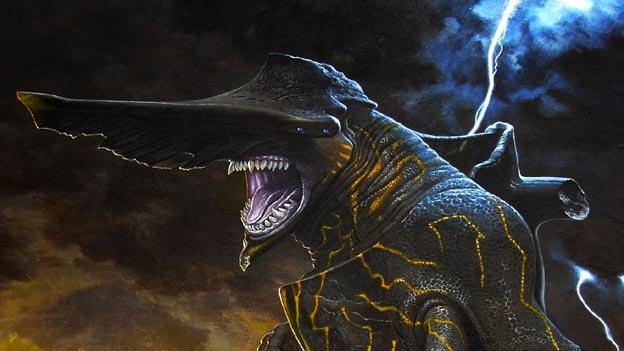Did Scots word inspire name of Pacific Rim monster?
- Published

Knifehead is among Pacific Rim's monsters with a name that is easier to explain away
Was a word in the Scots language the inspiration for a movie monster's name?
Pacific Rim is one of this summer's blockbuster offerings from Hollywood.
It imagines a future when giant robots called Jaeger defend the world against massive alien sea monsters.
Mexican director Guillermo del Toro's movie was inspired by Japanese kaiju films such as Godzilla. Kaiju means monster.
Pacific Rim's reptilian leviathans have names that describe their appearance, or have been influenced by real wildlife, or Japanese words.
And then there is Scunner.
It is a word in the Scots language that has had international exposure in the past.
A Cold War Soviet Union ballistic missile system, the R-1/SS-1, was dubbed Scunner by Nato.
According to US defence group, GlobalSecurity.org, Nato's nickname was inspired by a word in the "Scottish and northern dialect".
The Scots Language Centre in Perth confirmed that scunner is deeply rooted in the Scots language.
Dr Dauvit Horsbroch, the centre's language and information officer, said it was perfectly suited to a Hollywood monster.
"The word 'scunner' is first recorded in the Scots language in the 14th Century and found in all the dialects, so it is a universal Scots word," he said.
"You will hear it used in all forms of Scots."
"You can scunner at something meaning that you are disgusted by, repulsed, or repelled by a thing.
"You can call something or a person a scunner meaning they are very odious, horrible or disgusting. On the other hand, you might say a person is a scunner to mean they are just troublesome or have done something you didn't like.
"Whoever introduced it to the film certainly knew their Scots," he added.
Veteran broadcaster Robbie Shepherd, who was recognised for his services to Scottish culture and language with a Master of the University from Aberdeen University in 2001, associates the word with Doric.
Doric is one of 10 dialects in the Scots language.
Mr Shepherd said: "Scunner can mean you are feeling worse than fed up.
"I have always associated it with the north east of Scotland and Doric. I've not often heard it used anywhere else."
Frankenstein monster
Warner Bros and Legendary Pictures, the studios behind Pacific Rim, have not commented on the choice of scunner for a kaiju.
Some of del Toro's previous films have drawn inspiration from Scotland.
In Hellboy the star - a muscular red, horned demon - is summoned to Earth during Wolrd War II in a ritual ceremony performed on a fictional Scottish island.
The sequel, Hellboy II, features a fantasy creature with a Scottish accent.

Giant robots called Jaegers battle Pacific Rim's kaiju
Pacific Rim: Man, Machines and Monsters is a book published to coincide with the movie's release.
Its author, US journalist and writer David S Cohen, said names for the monsters developed during the making of the film.
"In general, the kaiju first got nicknames given by the concept artist team who created them," he said.
Cohen said one was dubbed Karloff because the look of it reminded the artists of a Frankenstein monster played by English actor and horror cinema icon, Boris Karloff, and with make up by legendary monster maker Jack Pierce.
Another kaiju was was called Bat-Ears Brady after a character in an old US radio programme.
"Then the names went through more iterations, presumably as marketing - they were going to be toys, after all - and legal weighed in," said Cohen.
"So you get some very descriptive names - Knifehead and Bladehead - some vaguely descriptive names such as Leatherback, some Japanese-flavoured names - Otachi and Onibaba which I think means 'hag' - and then, well, Scunner."
"I don't have any inside information on how Scunner got its name," the writer added.
So an air mystery continues to hang over the official line on how the monster got its name.
But maybe del Toro will clear matters up in the planned sequel by naming a new clutch of kaiju using Scots.
Only time will tell if audiences will see Min (Scots for man) and Horny Gollach (earwig) causing monster mayhem.